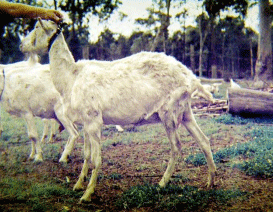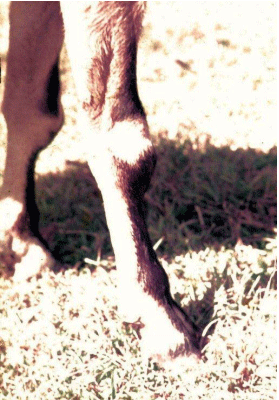What Disease Does This to Goats?
Published: March 1, 2015
By: Dr Sandra Baxendell, PSM, BVSc (Hons), PhD MANZCVSc, GCertAppSC(RurExt), GCertPSectMgt, PGDAppSc, MRurSysMan
From this

to this, 12 month later


There is NO treatment and NO vaccine.
It is mentioned in the National Goat Health Statement that should go with each NVD and in the National Kid Rearing Plan.
But, it is not Johne’s Disease nor gastrointestinal parasitism (although it wasting is a common sign and these goats could have these conditions as well as their resistance is reduced)
CAPRINE ARTHRITIS ENCEPHALITIS
CAE is caused by a slow virus and a member of the retrovirus family (like HIV-AIDS). It is from the subgroup, lentivirus, the same as the sheep disease Maedi Visna (also called Ovine Progressive Pneumonia), which is exotic to Australia. MV/OPP and CAE are so similar that it is suggested both must be controlled at the same time for either eradication programs to succeed. CAE viruses are attached to monocytes and macrophages.
Large numbers of viruses are in inflamed brain, spinal cord, lung, joints, & mammary gland cells of CAE positive goats. Smaller numbers are in uterus, lung, liver, spleen, lymph nodes, lining the vessels of brain, synovium, intestines, kidneys & thyroid.
Transmission is via bodily fluids. Milk and colostrum are the main sources of infection. Horizontal transmission between dry goats is unlikely, but still possible. There is very high risk if goats are milking or kidding. A single tiny intra-mammary dose can transmit CAE, so CAE positive goats should be milked last and milking machines well maintained. Overseas, sheep have acted as carriers.
The key message to goat producers is NEVER feed pooled milk to goat kids (unless it is pasteurised first).
Clinical signs take one of these following forms:
- Chronic Arthritis which starts as a periarthritis and progresses to deformed limbs and wasting
- “Hard Udder” - udder feels like a smooth stone under the skin with only a small amount of milk produced
- Chronic interstitial pneumonia with wasting and difficulty breathing
- Nervous signs (generally in kids)
Clinical signs can be very slow to show up and initially can be very mild e.g. just swollen carpus joints as shown in next photo. Signs increase with increased viral load in a herd.

Further Information
Facebook page – Let’s Eradicate CAE from Australian Goats see https://www.facebook.com/EradicateCAEinG oats?ref=hl
National Goat Health Statement (www.animalhealthaustralia.com.au/wpcontent/uploads/2011/04/GHS_form.pdf)
National Kid Rearing Plan (http://www.animalhealthaustralia.co m.au/national/kid/rearing/plan )
Slideshare presentations on CAE (http://www.slideshare.net/SandraBaxendell)
These US sites: http://www.goatbiology.com/caereferences.h tml and http://www.dairygoatjournal.com/issues/90/ 90-1/cae_prevention_and_management.html
Related topics
Authors:
Recommend
Comment
Share

Would you like to discuss another topic? Create a new post to engage with experts in the community.





.jpg&w=3840&q=75)